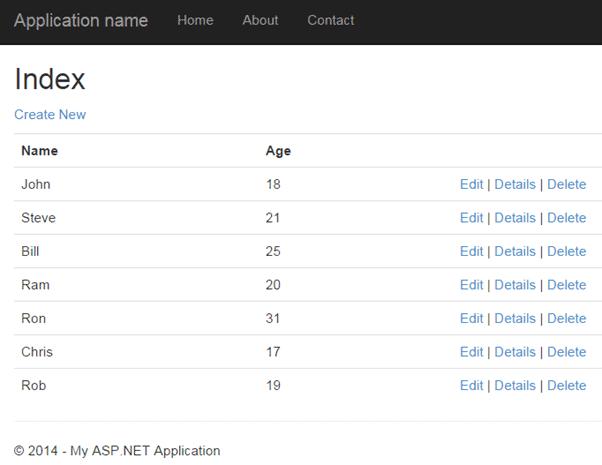Integrate Controller, View and Model
We have already created a Controller, a model and a view in the previous sections. Here, we will integrate them to run the application and see the result.
The following code snippet shows the StudentController, the Student model, and the Index.cshtml view created in the previous sections.
public class StudentController : Controller
{
// GET: Student
public ActionResult Index()
{
return View();
}
}public class Student
{
public int StudentId { get; set; }
public string StudentName { get; set; }
public int Age { get; set; }
}@model IEnumerable<MVC_BasicTutorials.Models.Student>
@{
ViewBag.Title = "Index";
Layout = "~/Views/Shared/_Layout.cshtml";
}
<h2>Index</h2>
<p>
@Html.ActionLink("Create New", "Create")
</p>
<table className="table">
<tr>
<th>
@Html.DisplayNameFor(model => model.StudentName)
</th>
<th>
@Html.DisplayNameFor(model => model.Age)
</th>
<th></th>
</tr>
@foreach (var item in Model) {
<tr>
<td>
@Html.DisplayFor(modelItem => item.StudentName)
</td>
<td>
@Html.DisplayFor(modelItem => item.Age)
</td>
<td>
@Html.ActionLink("Edit", "Edit", new { id=item.StudentId }) |
@Html.ActionLink("Details", "Details", new { id=item.StudentId }) |
@Html.ActionLink("Delete", "Delete", new { id = item.StudentId })
</td>
</tr>
}
</table></code></pre>
<div className="card-footer example-footer"></div></div>
</div>
<p>
Now, to run it successfully, we need to pass a model object from an action method to a view.
As you can see in the above <code>Index.cshtml</code>, it uses <code>IEnumerable<Student></code> as a model type.
So we need to pass it from the <code>Index()</code> action method of the <code>StudentController</code> class, as shown below.
</p>
<div className="card code-panel">
<div className="card-header example-header"><div className="example-caption">Example: Passing Model from Controller</div><button className="copy-btn pull-right" title="Copy example code"><i className="fa fa-copy"></i> Copy</button></div>
<div className="panel-body">
<pre className="csharpcode">
<code>public class StudentController : Controller
{
static IList<Student> studentList = new List<Student>{
new Student() { StudentId = 1, StudentName = "John", Age = 18 } ,
new Student() { StudentId = 2, StudentName = "Steve", Age = 21 } ,
new Student() { StudentId = 3, StudentName = "Bill", Age = 25 } ,
new Student() { StudentId = 4, StudentName = "Ram" , Age = 20 } ,
new Student() { StudentId = 5, StudentName = "Ron" , Age = 31 } ,
new Student() { StudentId = 4, StudentName = "Chris" , Age = 17 } ,
new Student() { StudentId = 4, StudentName = "Rob" , Age = 19 }
};
// GET: Student
public ActionResult Index()
{
//fetch students from the DB using Entity Framework here
return View(studentList);
}
}As you can see in the above code, we have created a list of student objects for an example purpose (in real-life application, you can fetch it from the database). We then pass this list object as a parameter in the View() method. The View() method is defined in the base Controller class, which automatically binds a model object to a view.
Now, you can run the MVC project by pressing F5 and navigate to http://localhost/Student. You will see the following view in the browser.
